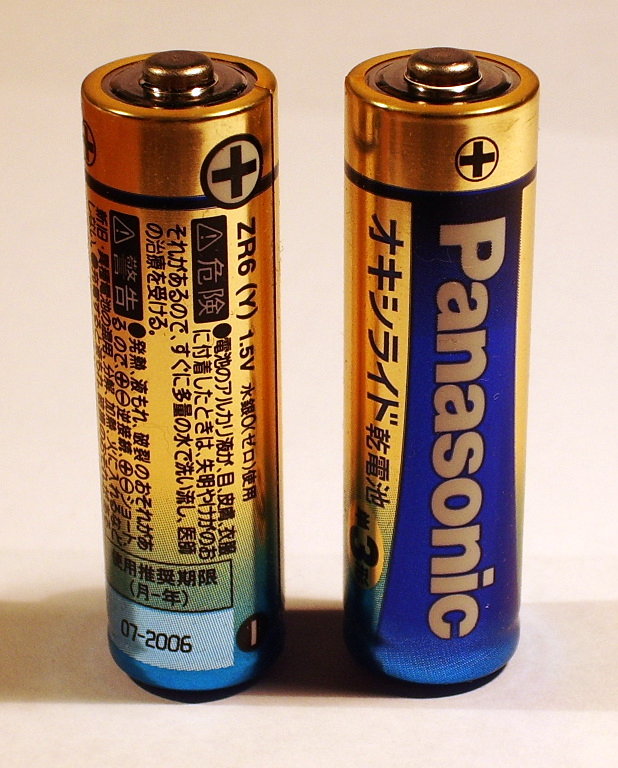NiOx Battery on:
[Wikipedia]
[Google]
[Amazon]
A nickel oxyhydroxide battery (abbr. NiOx, IEC code: Z) is a type of 

An example of an equipment manufacturer testing nickel oxyhydroxide batteries. Finer grained graphite in the cathode and a vacuum pouring process that inserts a higher quantity of electrolyte in the cell are used during the manufacturing of the nickel oxyhydroxide cells.Katerina E. Aifantis, Stephen Andrew Hackney, Stephen A. Hackney, R. Vasant Kumar (ed) ''High Energy Density Lithium Batteries: Materials, Engineering, Applications'', Wiley-VCH, 2010 page 49
Can a New Disposable Battery Change Your Life? Parts of It, Maybe
by
New Consumer Primary Battery Chemistry Introduced after a 40-year Dryspell
Panasonic Oxyride Editorial Review - The Revolution in Battery Power
{{Galvanic cells Disposable batteries
primary cell
A primary battery or primary cell is a battery (a galvanic cell) that is designed to be used once and discarded, and it is not rechargeable unlike a secondary cell ( rechargeable battery). In general, the electrochemical reaction occurring in ...
. It is not rechargeable and must be disposed after a single use. NiOx batteries can be used in high-drain applications such as digital camera
A digital camera, also called a digicam, is a camera that captures photographs in Digital data storage, digital memory. Most cameras produced today are digital, largely replacing those that capture images on photographic film or film stock. Dig ...
s.
NiOx batteries used in low-drain applications have lifespans similar to alkaline batteries. NiOx batteries produce a higher voltage (1.7V) than alkaline batteries (1.5V) which can cause problems in certain products, such as equipment with incandescent light bulbs
An incandescent light bulb, also known as an incandescent lamp or incandescent light globe, is an electric light that produces illumination by Joule heating a filament until it glows. The filament is enclosed in a glass bulb that is either ...
(such as flashlights/torches) or devices without a voltage regulator.


Construction
The nickel oxyhydroxide cell is different from a standardalkaline battery
An alkaline battery (IEC code: L) is a type of primary battery where the electrolyte (most commonly potassium hydroxide) has a pH value above 7. Typically, these batteries derive energy from the reaction between zinc metal and manganese diox ...
in the manufacturing process and in chemical composition.
The chemical difference is the addition of nickel oxyhydroxide to the manganese dioxide
Manganese dioxide is the inorganic compound with the formula . This blackish or brown solid occurs naturally as the mineral pyrolusite, which is the main ore of manganese and a component of manganese nodules. The principal use for is for dry-cel ...
and graphite
Graphite () is a Crystallinity, crystalline allotrope (form) of the element carbon. It consists of many stacked Layered materials, layers of graphene, typically in excess of hundreds of layers. Graphite occurs naturally and is the most stable ...
for the cathode
A cathode is the electrode from which a conventional current leaves a polarized electrical device such as a lead-acid battery. This definition can be recalled by using the mnemonic ''CCD'' for ''Cathode Current Departs''. Conventional curren ...
. This results in an unloaded voltage of 1.7 V DC per cell. The cells sustain a higher average voltage during discharge compared to alkaline batteries, which may cause a false indication in equipment that monitors battery voltage as an indication of remaining operating time.An example of an equipment manufacturer testing nickel oxyhydroxide batteries. Finer grained graphite in the cathode and a vacuum pouring process that inserts a higher quantity of electrolyte in the cell are used during the manufacturing of the nickel oxyhydroxide cells.Katerina E. Aifantis, Stephen Andrew Hackney, Stephen A. Hackney, R. Vasant Kumar (ed) ''High Energy Density Lithium Batteries: Materials, Engineering, Applications'', Wiley-VCH, 2010 page 49
See also
*List of battery types
This list is a summary of notable electric battery types composed of one or more electrochemical cells. Three lists are provided in the table. The primary (non-rechargeable) and secondary (rechargeable) cell lists are lists of battery chemistry. ...
References
External links
Can a New Disposable Battery Change Your Life? Parts of It, Maybe
by
David Pogue
David Welch Pogue (born March 9, 1963) is an American technology and science writer and TV presenter, and correspondent for ''CBS News Sunday Morning''.
He has hosted 18 ''Nova'' specials on PBS, including '' Nova ScienceNow'', the ''Making Stu ...
New Consumer Primary Battery Chemistry Introduced after a 40-year Dryspell
Panasonic Oxyride Editorial Review - The Revolution in Battery Power
{{Galvanic cells Disposable batteries